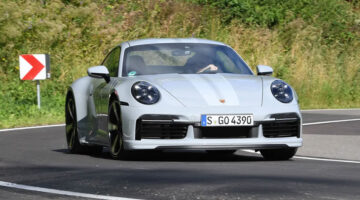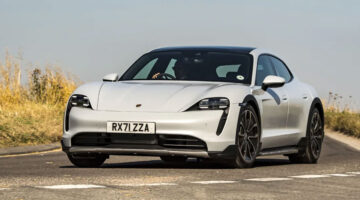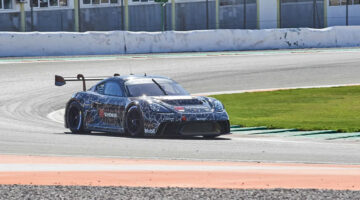Porsche’s GT3 Touring, GT3, GT3 RS and GT2 RS are the most hardcore of the 911
It’s no secret that over here at
I find myself in the GT3 first, and this Gen 2 991 really is a great example of how Porsche squeezes the juice from a car so hard you can almost hear its pips squeak. Going from 3.8 to 4 litres brings torque benefits, but considerable effort was also made to reduce frictional losses. The result is 493bhp, 339lb ft and a rev limiter at 9000rpm, plus a spine-tingling soundtrack that’s taken straight from the racetrack. Despite being finished in Guards Red this GT3 looks surprisingly restrained, thanks largely to the modest rear wing and lack of additional slots and scoops that pepper the RSs. It’s still a brilliantly focused machine, though: simple, functional and supremely fit for purpose.
A couple of startled cyclists aside, the roads ahead are mainly deserted. There’s no reason to worry about noise, so it seems rude not to open the exhaust, and as the surface on the first stretch of the route is unusually smooth it’s also right to crank the PASM into its stiffest mode.The GT3 is a fabulously communicative car to drive hard. There’s a level of pliancy and progression to help you feel your way towards its limits, but also great depths of grip and traction from which to draw. That the GT3 is a great driver’s car is no surprise, but what did take me off-guard is how comfortable it is as an everyday proposition. If there wasn’t a wing in the rearview mirror, you’d be forgiven for mistaking it for a regular 911 during the more mundane parts of our drive.
With my time in the ‘standard’ GT3 coming to an end I swap seats for the Touring, which for those of you unfamiliar with it, is a purist’s dream manual-only version of the GT3 that deletes the fixed wing and replaces it with a classic pop-up rear deck, albeit embellished with a ‘GT3 Touring’ badge and a unique lip spoiler on the trailing edge. After a few years of being denied the pleasure of a manual option I’m personally grateful for Porsche’s volte-face on its PDK-only policy for GT models. This is a rare opportunity to try a state-of-the-art car with a traditional manual transmission, and it doesn’t disappoint. Porsche has continuously improved its seven-speed manual, but this six-speed version is even better. There’s a switchable auto-blip function, which gets some people very hot under the collar, but I actually rather like it, even if I do prefer to do the blipping myself.
At first it feels strange to be pumping a clutch pedal and working a gearlever, but Porsche clearly hasn’t forgotten about the importance of matched control weights and smooth, well-judged response.
Having to change gear the old-fashioned way adds to the workload, but it unquestionably bonds you more closely to the process of going quickly, not to mention gives you tremendous cause for satisfaction when you nail your upshifts and downshifts.
The PDK car definitely has its own appeal, but the pleasure of working the manual transmission more than offsets the fractional sacrifice in pace. I also find the grown-up looks of the Touring refreshing, and walk away with the feeling I’ve just driven a more subtle, more attainable version of the highly sought after limited-run 911R minus the stripes.
On the opposite end of the subtlety spectrum is the GT3 RS, and there’s no point denying it: I have the major hots for this car. Have done ever since I first laid eyes on it. I suspect this love is not universally shared, at least not by those who have got used to the previous-generation 3RS being a genuinely everyday useable car.
There’s certainly more grit to its delivery than the GT3 and a sense that you’re one layer closer to the working parts of the car – a result of less sound-deadening to save a few more kilos. It’s the first clue to the 3RS’s pricklier character, which reveals itself more completely once you start exploring its stratospherically high limits.
Fabulous though it is in the GT3, the naturally aspirated 4.0 flat-six has a more serrated edge and even more snap when you squeeze the throttle in the RS – delicious, visceral confirmation of the spec sheet gains of 20bhp and 8lb ft, taking the totals to 513bhp and 347lb ft.
The feeling of urgency and aggression is captivating from the moment you get some heat in the tyres – doubly so if, as here, they happen to be Michelin’s freakishly effective Pilot Sport Cup 2 Rs. These are the tyres used to set Porsche’s Nürburgring records, and whenever you ask the RS to stop, steer or accelerate you can see why. They are voodoo.
What’s clear regardless of the tyres is the 3RS’s beautiful balance and incredible ability to support quick changes of direction – both areas of improvement credited to the RS’s rose-jointed suspension and significant gains in aerodynamic downforce.
Inevitably this means a little more of the 911’s rear-engined traits have been erased in the pursuit of poise and pace, but they’re still there to be exploited if you’re prepared to dig deep enough and want to slide it around.
It’s been a while since the difference between GT3 and 3RS has been this marked. Indeed I’d say you need to go right back to the Gen 2 996 to find such an uncompromising RS, but in creating greater separation between these closely related models Porsche has actually improved both.
Next up is the GT2 RS, and my anticipation is palpable. I’ve been wanting to get behind the wheel of this beast from the moment I read its stat sheet, and I finally get to experience the most powerful 911 ever. From the moment you fire it up you know you’re in for a very different experience. Clearly working on the principle if you’re going to be a bear, be a grizzly, the GT2 throbs and pulses with anger and energy. Its engine note is deeper and more malevolent, even at idle. This is a piece of heavy artillery, no question.
There are close similarities in set-up between the 3RS and the 2RS, so it’s no surprise to feel that familiarity through the steering and the seat of your pants. It’s lighter in your hands than you might expect, but once you get heat into its Cup 2s it keys in and the feel begins to flow through your fingers.
What transforms the experience is the utterly different delivery of the monster twin-turbocharged motor. Where the naturally aspirated 4.0 is ultra-sharp and builds to a wild crescendo of revs, this turbo’d 3.8 has a ballsier, more muscular demeanour. It thumps hard and early, wrapping you in a straightjacket of longitudinal G-force and working the chassis and tyres in a less linear way. Of course, there’s still finesse to the way it goes to work – this is no laggy, old school F40 – but the sheer torque on tap means you need to be a little more sympathetic to the rear tyres’ workload and sometimes pre-empt when the meat of the boost will arrive.
The GT2 RS places a different emphasis on your driving, too. The difference in peak speeds along the straights is massive, and that forces you to focus a little harder on nailing your braking markers, as the extra few kph (and the extra few kilos) place even more emphasis on the braking zones. When the roads gets particularly tight and the corners more angled is where the 2RS’s additional weight and softer engine response are most apparent. It’s far from lethargic, obviously, but there’s just that fraction more inertia to its direction changes and you can’t make the fine throttle adjustments that help to tickle the GT3s through with such deftness and precision. That said, it counters with monumental shove out of the corners and down the straights. It’s the kind that always makes your heart beat faster and harder and gives rise to a slightly giddy feeling as your innards are shifted within your body cavity.
What’s more, the 2RS deploys this epic power (690bhp) and torque (553lb ft) with astonishing effectiveness. Yes, you can light it up and bonfire the tyres – fun if you’re not paying for the replacement rubber and testament to how well the 991 handles outputs that would just a few years ago have seemed like lunacy in a 911 – but the measured exploitability of the 2RS’s performance is just as remarkable.
It’s in marked contrast to the 997 GT2 RS, which was a real flick-knife of a car. Whether or not the new car could do with a little more of its predecessor’s ferocity is up for debate. The current car is certainly more docile than you’d ever expect from a near-700bhp 911, but I’m not sure I’d want it to be quite as explosive as the 997.
It might not feel like it wants to kill you, but the 2RS is a big character. In fact it’s almost two cars in one: civilized enough to work as a road car in which you’d be happy to cover big miles, yet wild enough to deliver an intense adrenaline rush if you’re prepared to hang it out.
It’s fascinating to discover the differences between these four closely related 911s. Taken in isolation each is a magnificent car, but stepping from one to the other gives you a wonderfully warped perspective. How else can you explain feeling that the manual Touring and PDK GT3 are the soft and friendly member of the bunch?
Of course, they aren’t soft by any normal benchmark, but relative to the significantly stiffer and solid-mounted RSs they feels much more rooted in road use, the GT3 Touring in particular. The manual transmission adds a layer of interaction, but turns down the intensity a notch. The 4-litre motor is magnificent in both cars, but it doesn’t quite have the final nth degree of response and aggression possessed by the RS GT3. And, of course, it doesn’t have the stonk of the GT2 RS.
And what of the comparison between the two RSs? Honestly, despite the shared chassis set-up they are different enough that you could easily justify having both in your garage. I love the 2RS’s potency and the ferocity of its on-boost acceleration. I also love the immense force with which it pulls a tall gear. It’s everything you want a hardcore turbocharged 911 to be.
However, for
| Porsche 911 | GT2 RS |
|---|---|
| Engine: | Flat-six, 3800cc, twin-turbo |
| Power: | 690bhp @ 7000rpm |
| Torque: | 553lb ft @ 2500-4500rpm |
| Weight (kerb) | 1470kg |
| Power-to-weight | 477bhp/ton |
| 0-100kph: | 2.8secs |
| Top speed: | 339kph |
| Basic Price: | $266,830 |
| Porsche 911 | GT3 |
|---|---|
| Engine: | Flat-six, 3996cc |
| Power: | 493bhp @ 8250rpm |
| Torque: | 339lb ft @ 6000rpm |
| Weight (kerb) | 1413kg |
| Power-to-weight | 355bhp/ton |
| 0-100kph: | 3.9secs |
| Top speed: | 318kph |
| Basic Price: | $143,765 |
| Porsche 911 | GT3 Touring |
|---|---|
| Engine: | Flat-six, 3996cc |
| Power: | 493bhp @ 8250rpm |
| Torque: | 339lb ft @ 6000rpm |
| Weight (kerb) | 1413kg |
| Power-to-weight | 355bhp/ton |
| 0-100kph: | 3.9secs |
| Top speed: | 318kph |
| Basic Price: | $143,765 |
| Porsche 911 | GT3 RS |
|---|---|
| Engine: | Flat-six, 3996cc |
| Power: | 513bhp @ 8250rpm |
| Torque: | 347lb ft @ 6000rpm |
| Weight (kerb) | 1430kg |
| Power-to-weight | 364bhp/ton |
| 0-100kph: | 3.2secs |
| Top speed: | 310kph |
| Basic Price: | $181,755 |



